- News
- Events
- Oneg Shabbat
- Collections
- Research
- Exhibitions
- Education
- Publishing Department
- Genealogy
- About the Institute
- Bookstore

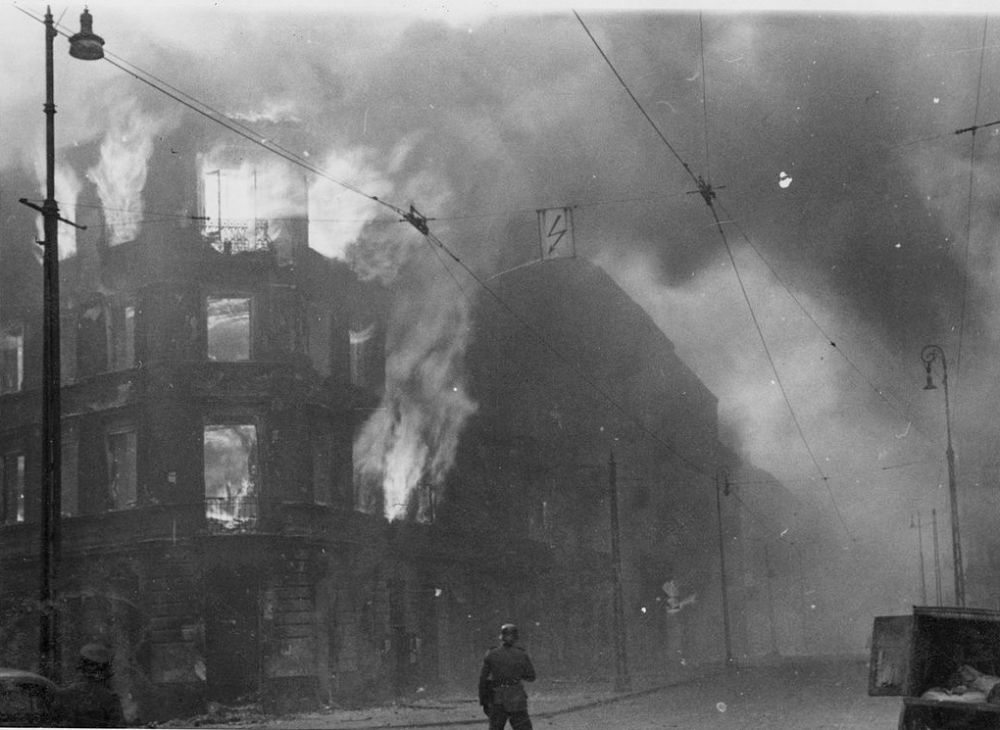
Warsaw Ghetto Uprising, burning tenements on the corner of Zamenhofa 25/Wołyńska 2 streets. Stroop Report
The term ‘revisionists’ is usually used to describe pre-WWII right-wing Jewish organizations and political parties. The core of the JMU stemmed from the Betar organization, established in 1923 by Russian Jewish political activist Vladimir (Ze’ev) Zhabotinski. Betar supported Zionism, at the same time opposing socialism, capitalism as well as Marxism. This positioned them against left-wing parties which dominated in the Zionist movement, and from which the JCO originated in the Warsaw Ghetto.
The history of the JMU was surrounded by many myths, eventually explained in Dariusz Libionka and Laurence Weinbaum’s Bohaterowie, hochsztaplerzy, opisywacze: wokół Żydowskiego Związku Wojskowego [Heroes, Hucksters and Story-Tellers: On the Jewish Military Union in the Warsaw Ghetto] published in 2011.
Situation in the Warsaw Ghetto after the Great Deportation
The Great Deportation, conducted by the Germans in the summer of 1942, was a shock to the Warsaw Ghetto. The majority of the population – about 300,000 people – were deported to the Treblinka extermination camp. As a result, revisionist groups active in the ghetto, such as Betar, Masada or Irgun, decided to make attempts towards unification and cooperation. The same scenario occurred among the left-wing Zionist groups, which led to founding of the JCO. It is difficult to estimate at which moment exactly the revisionist military formation emerged. The strongest faction among them was Betar. Contrary to other organizations in the ghetto, the revisionists didn’t conduct any activities related to publishing or education, hence we don’t have access to any resources which could provide a more detailed background of the foundation of the JMU. We know that in 1942, many members of Betar stayed near Hrubieszów (a town in today’s Eastern Poland); most of them were killed by the Germans, while the remaining few returned to the Warsaw Ghetto and later contributed to the military resistance.
One of the JMU members, known today only as ‘Rudy Paweł’ (‘Ginger Paul’), joined the revisionists only in early 1943. In his memoirs, written down shortly after the Warsaw Ghetto Uprising, he mentioned that the JMU was established in January of February of 1943. The writings of Emanuel Ringelblum, historian, founder of the Oneg Shabbat underground organization, provide a description of the JMU’s activity – Ringelblum was aware of many details of their story, but didn’t mention the date and circumstances of their origin.
Members of the JMU as well as the JCO knew that contacts with the ‘Aryan’ side, especially with members of the Polish resistance, were necessary in order to gain access to arms and support in terms of logistics. Most likely, people linked to the JCO as well as to revisionists made attempts to contact the Polish underground movement at a similar time, but – as Libionka and Weinbaum note – only the JCO’s efforts proved successful. As a result, the organization had monopolized contact with the Home Army, and the JCO’s perspective on the conditions in the residual ghetto (the part remaining after the Great Deportation) became decisive for the Polish side.
Was it actually ever possible to join forces and to establish one military organization in the Warsaw Ghetto? Cooperation between various groups, not only among left-wing Zionists and revisionists, was often impossible due to political differences. There were no revisionists in the JCO, originally even no Bund members belonged there[1]. On the other hand, the Home Army leadership insisted on contact with one organization which would represent the most important political factions in the ghetto. This situation led to establishment of a political organization, the Jewish National Committee, and the Coordinating Committee, established in order to satisfy Bund (who didn’t accept the JCO Zionists’ political programme). The description of the JNC, prepared by Henryk Woliński from the Jewish Unit at the Home Army’s Bureau of Information and Propaganda (Biuro Informacji i Propagandy AK), ‘revisionists’ appeared in a note dated 3 November 1942. Gradually, they became increasingly marginalized. Representatives of the revisionists couldn’t come to terms with leaders of the JCO, neither were they willing to follow the organization’s orders and to donate their arms. Libionka and Weinbaum write that ‘a conflict regarding leadership broke out and neither side stepped down’. Eventually, both groups acted independently.
Adam Halperin, Betar and JMU member, explained reasons for lack of agreement between the JCO and the revisionists: ‘Why did the JMU, the second independent combat organization of the Warsaw Ghetto, emerge? It happened due to the fact that the leaders of the JCO, the first organization, didn’t agree to include Betar into the organization as a separate unit. (…) The privilege of group membership, extended onto all the other organizations, didn’t include Betar. Its members were allowed for individual access, but not as an organized block’.
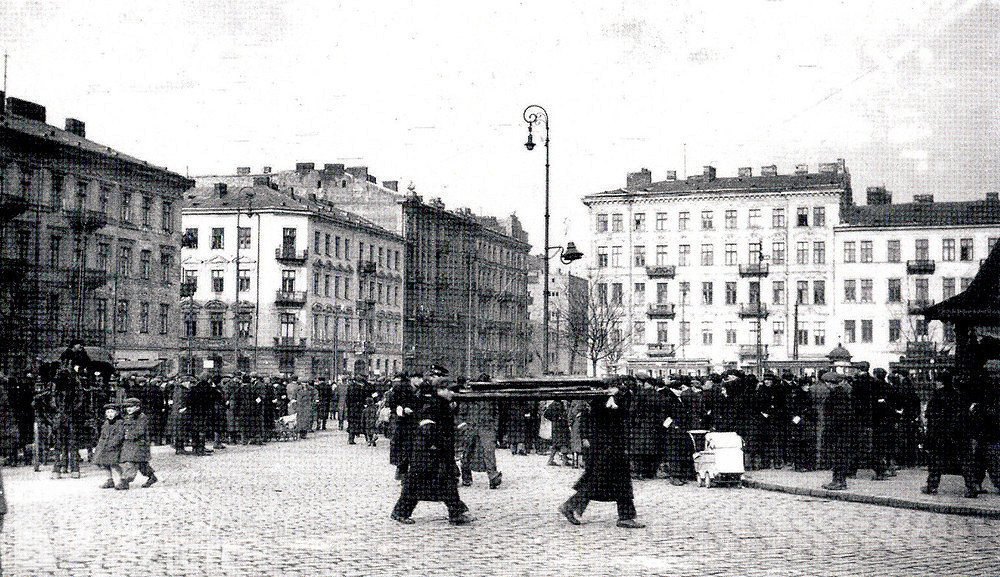
Armory at Muranowska street
It is impossible to provide an exact number of the JMU members. According to the Home Army’s Bureau of Information and Propaganda, in January 1943 the group comprised about 150 people, armed with purchased guns, and in control of the tunnel between the ghetto and the ‘Aryan’ side of Muranowska street. Some sources claim that the organization numbered several dozen people; in certain publications, such as Barbara Engelking and Jacek Leociak’s Getto warszawskie. Przewodnik po nieistniejącym mieście [The Warsaw Ghetto: A Guide to the Perished City] we can read that before the uprising, the JMU consisted of about 260 members.
It can be certainly said that not all of the JMU’s members were linked in any way to the revisionist movement. At least part of them joined the group because they couldn’t, or didn’t want to, join the JCO. For the JMU, owning arms and the ability to use them was a key factor, rather than political affiliation.
The JMU was purchasing arms through contact with PLAN (Polska Ludowa Akcja Niepodległościowa, Polish People’s Action for Independence). The liaison was Cezary Ketling-Szemley, known also as ‘Janusz’, ‘Ketling’ and ‘Arpad’. According to Ringelblum and ‘Rudy Paweł’, resources to buy arms came from expropriations in the ghetto – the revisionists were exhorting money from wealthy people. The JMU, contrary to the JCO, didn’t receive arms from the Polish resistance. Their contacts with PLAN were of business nature.
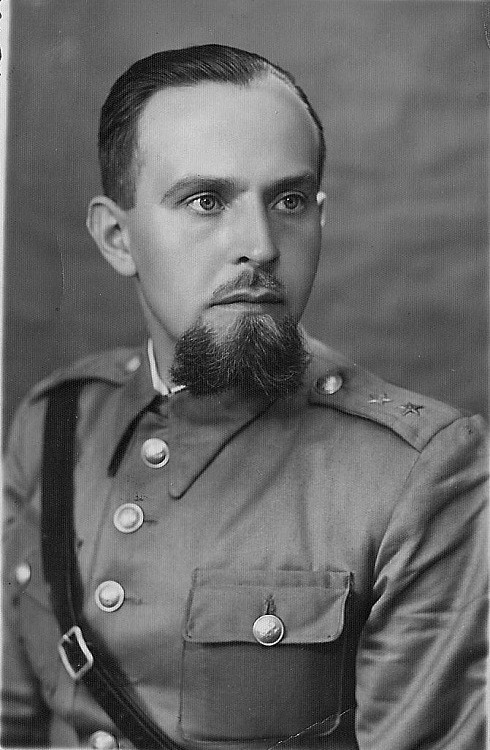
The JMU headquarters were located at 7/9 Muranowska street. Ringelblum paid a visit there right before the Uprising broke out: ‘I’ve seen the JMU armory. It was located in an uninhabited, “wild house” at 7 Muranowska street, in a 6-room apartment on the first floor. The leadership room was equipped with an excellent radio, providing information from the world, as well as a typewriter. Members of the JMU leadership, whom I’ve been talking to for several hours, carried guns on their belts. In the main halls, diverse arms were hung, such as light machine guns, rifles, revolvers of all kinds, hand grenades, bags with ammunition, German uniforms, which were so successfully used in the April operation, and others. The leadership room was very busy, like actual army headquarters; they received orders for “stationing points”, in which they were training future insurgents. Reports from expropriations, carried out by various groups on wealthy people in order to arm the JMU, were also brought here. In my presence, they purchased arms worth quarter a million zlotys from a former Polish Army officer, paying a 50,000 zloty advance; they also bought two machine guns which cost 40,000 zloty each, as well as a large number of hand grenades and bombs’.
The place was also described by one of few JMU members who had survived the war, Ryszard Walewski (Abraham Lewi), in 1948 r.: ‘The organization’s headquarters were located at 7/9 Muranowska street, where also the main units were stationing. The basement with concrete ceiling was turned into a bunker, built according to all the rules of ‘underground architecture’, with all necessary equipment, also for self-defence, and with a direct exit towards the ‘Aryan side’. The overground floors were turned into an actual stronghold. Aside from this house, JMU units were staying in tenements on the early odd-numbered side of Muranowska street’. According to Libionka and Weinbaum, Walewski added that the JMU had two machine guns at Muranowska street. Available reports and description of battles suggest that the JMU could have owned a maximum of 2–3 machine guns in general.
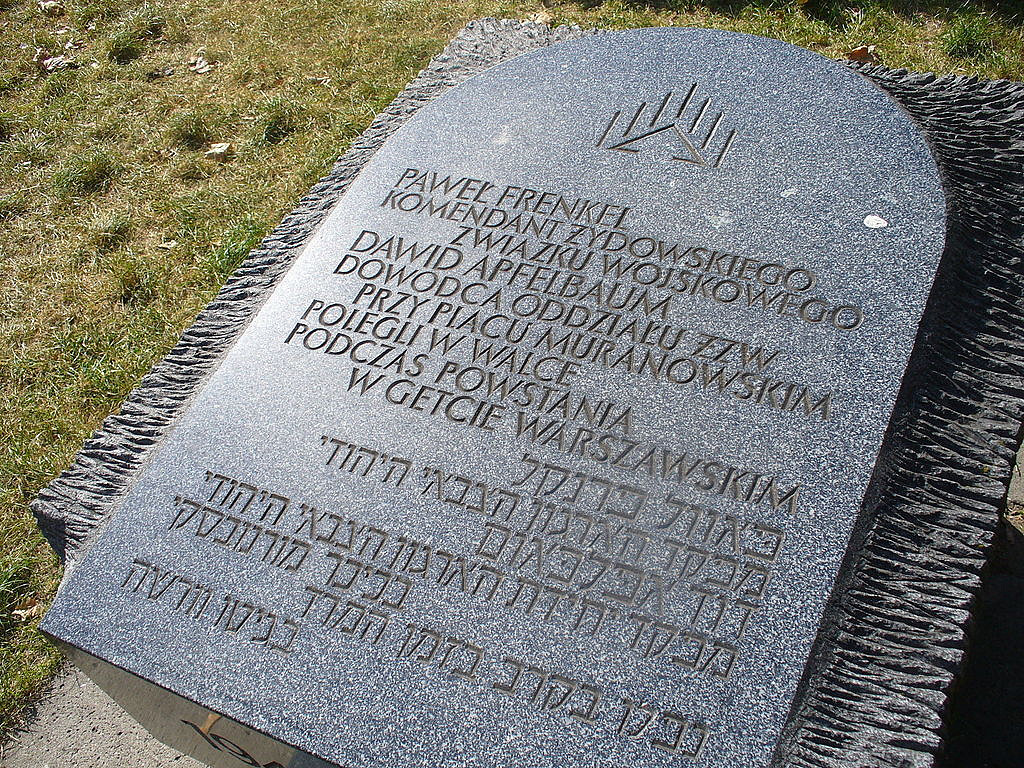
The mystery of the JMU commander
The JMU’s commander was most likely Paweł Frenkel, a member of Betar. For many years it was assumed that the group was led by one Dawid Apfelbaum – who most likely never existed. In case of Frenkel it is impossible to confirm whether Paweł (Paul) is his true name or pseudonym. Both Frenkel and Leon Rodal, another Betar and JMU leadership member, also linked to New Zionist Organization, were mentioned by Ringelblum in a letter from 13th December 1943, written to Adolf Berman from the Jewish National Committee while the historian was hiding in the ‘Krysia’ bunker in the Warsaw district of Ochota:
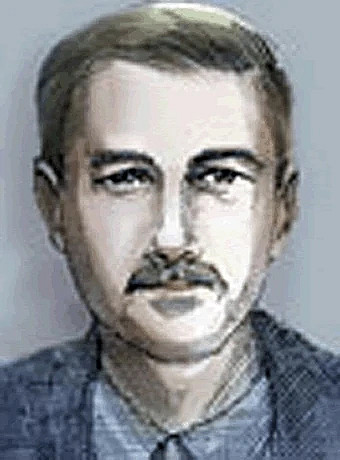
‘I received the list of the company’s [JCO] associates. I have biographical data about several persons (…). Somebody should collect data about all of them (date of birth, place of living, parents’ jobs, education, character, participation in various projects, latest project etc.) (…). Why there is no information about JMU? Even though we are not friends, a trace of them should belong to history’. Two weeks later, in a letter from 27th December 1943, Ringelblum wrote: ‘As with the revisionists, I have no information about them. At T [Trawniki] I talked to Mr Cwikowski. He was very dissatisfied with their work. His criticism was similar to ours, but still we should supplement the list. I know only two surnames: Rodalski and Frenklowski. The latter (the black-haired) was the manager of the company. We should find one of them or one of their colleagues’.
Mr Cwikowski is the encrypted surname of another JMU member, Dawid Szulman, whom Ringelblum encountered in Trawniki labor camp after he was sent there by the Germans in the early days of the Warsaw ghetto uprising. At Trawniki, Szulman became one of the leaders of the camp’s underground. According to Libionka and Weinbaum, the fact that Ringelblum indicated Frenkel as the ‘manager of the company’ makes it sure that he was the leader of JMU.
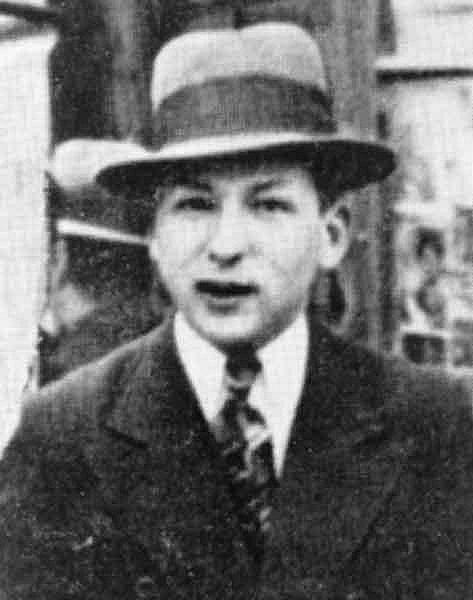
Moshe Arens, researcher of JMU’s history and former Israeli foreign affairs and defense minister, mentions Dawid Apfelbaum as part of JMU’s command. It is most likely that the JMU was not commanded by the triumvirate of Frenkel-Rodal-Apfelbaum, as Arens wrote, but similarly to JCO, had one specific leader. There are no reliable documents that would confirm the existence of Apfelbaum. The previously mentioned Adam Halperin of JMU also registered that Frenkel was the leader of the group. He wrote: ‘P. Frenkel of Betar led the JMU’, other members of the command were in his words Natan Schulz, Salek Hasensprung, Leon Rodal, Eliahu Halberstein and Icchak Bielawski, while Dawid Wdowiński and Michał Strykowski were ordinary members.
The Uprising begins
During the Warsaw Ghetto Uprising, JMU had its headquarters at Muranowska 7/9 Street. The organization controlled a tunnel leading to a neighboring building on the ‘Aryan’ side. On the order of Heinz Auersweld, the ghetto’s German commissar, the even-numbered side of Muranowska street was excluded from the ghetto on 23rd June 1942, shortly before the Great Deportation. The tunnel was built during the deportation or shortly after it was finished. The JMU squads were located also in two other places: group commanded by Pinchas Taub stayed in Toebbens and Schultz’s szop (pronounced ‘shop’, this was the name for ghetto workshops producing goods for the German army by means of slave labor) and in the brush makers’ szop at Świętojerska street stayed Chaim Łopata’s group.
The JCO had its headquarters firstly at Miła 29. The organization had several hundred members, divided into groups numbering 10 to 12 people in various places in the ghetto. The leader was Mordechaj Anielewicz, who before the war belonged to Hashomer Hatzair (‘The Young Guard’) youth organization. After his death on 8th May, he was replaced by Marek Edelman from Bund.
On 19th April 1943, the Germans entered the ghetto. Their objective was the total liquidation of the Jewish quarter in Warsaw. They possessed numerical superiority and incomparably better equipment than the Jews. SS — und Polizeiführer Warschau (SS and police leader in Warsaw) Ferdinand von Sammern-Frankenegg threw into battle SS men, policemen, gendarmes, Wehrmacht soldiers and Ukrainian troops, armed with rifles, submachine guns, light and heavy machine guns, artillery, flamethrowers, armored vehicles and tanks. The attack commenced from two sides – the Nalewki street and the crossing of Gęsia and Zamenhofa streets. After two hours of fighting, the Germans withdrew due to the strong Jewish resistance. Von Sammern-Frankenegg was dismissed and replaced by SS-Brigadeführer (major general) Jürgen Stroop. Soon the Germans entered the ghetto again. Heavy fighting broke out in two areas: the JCO defended the crossing of Nalewki and Gęsia streets, while the JMU held the Muranowski square.
In the opinion of Ryszard Walewski, who however did not belong to the strict JMU leadership, and ‘Rudy Paweł’, the Union had a following plan: offer armed resistance as long as possible, then exit the ghetto through the tunnel, and continue guerilla warfare on the ‘Aryan’ side.
About the participation of JMU in the uprising Ringelblum wrote in his essay Polish-Jewish Relations During the Second World War [Stosunki polsko-żydowskie w czasie drugiej wojny światowej. Uwagi i spostrzeżenia]: ‘We will not describe here in detail the fights with the Germans in April 1943. Several particular groups fought in the ghetto, at the brush makers’ szop, on the Świętojerska street, at Toebben’s and Schulz’s szop etc. Fighting took place on the roofs of tenements, where two flags appeared: the Polish and the Zionist (white-and-blue). On Monday 18th April [it should be 19th April – BB], from the 5th floor of the building on Nalewki 32 I saw with my own eyes fighting on Muranowska street’. Accoring to Libionka and Weinbaum, it is possible that Ringelblum saw the JMU in combat. There is no certainty whether he saw the two flags or learned about them from someone else, as he was writing the essay in the ‘Krysia’ bunker.
The theme of two flags – Polish, white-and-red, Jewish, white-and-blue – raised by the fighters appeared in many accounts of the uprising. However, it is difficult to ascertain where the flags were located. If they were located on the crossing of Muranowski square and Nalewki 42, Ringelblum, who was hiding at Nalewki 32, was able to see them. The revisionist fighters, who raised the flags, wanted to show their patriotism and devotion to the Polish national symbols. It is difficult to imagine a leftist Zionist group make such a sign. The information about the two flags appeared in some reports of the Polish resistance, such as a document prepared by counterintelligence of Government Delegation for Poland (Delegatura Rządu na Kraj) on 23rd April 1943 and New Day (Nowy Dzień) underground newspaper from 21st April 1943. Neither the Polish Home Army’s Information Bulletin (Biuletyn Informacyjny AK) nor the telegrams sent to Polish government-in-exile mentioned the event.
After the war, former JCO fighters and their associates sometimes ignored the JMU’s participation in the uprising. Marek Edelman wrote in his 1945 book The Ghetto Fights [Getto walczy. Udział Bundu w obronie getta warszawskiego] about the battle of 19th April 1943: ‘(…) heavy fighting at Muranowski square. The Germans are attacking from all directions. The trapped fighters are defending fiercely, repelling attacks in superhuman struggles. Two machine guns and lots of other firearms are captured. A German tank is burned – the second this day’. Bund liaison officer Władka Meed wrote about the revisionists’ fighting without giving the proper name of JMU: ‘On the same day at Muranowski square there was one last battle for the last resistance point. A squad fighting there was formed by another of the ghetto’s underground organizations. It was the right-wing Revisionist Zionist Movement [‘Rewizjonistyczny Ruch Syjonistów’], independent from the JCO. Quite well armed, it managed to repel several attacks and for two days held the Muranowska street’. JCO’s Cywia Lubetkin noted in her memoirs that ‘members of the revisionist group bravely defended the street. On 20th April they repelled all German attacks and the enemy suffered heavy losses’. Icchak Cukierman, JCO’s liaison officer with the Polish underground, wrote about the JMU without giving the name: ‘the group defended the street bravely and toughly. On 20th April they held off German attacks, inflicting heavy losses on the enemy’.
After the combat at Muranowski square, part of the JMU’s fighters left the ghetto through the tunnel. However, it is not clear when it precisely happened. Dates between 20th and 22nd April are mentioned. ‘Rudy Paweł’ wrote: ‘On 22 April we are withdrawing to the Aryan side on the order of the officer cadet, who is with us all the time. Some of us had German uniforms, all had helmets. We are staying in a flat at Muranowska street. We have firearms, some 200 grenades – rifles. It is uncomfortable here. The doorkeeper brought us food’. Part of the group – 44 fighters – got through to a residence in Michalin (Warsaw suburb), rented by the mentioned Cezary Ketling-Szemley. But after a few days, on 30th April, they were discovered by the Blue Police (Polish auxiliary police under German leadership, maintaining public security) and German gendarmes. In a shootout, some of the fighters were killed.
The JMU’s initial plan of guerrilla warfare against the Germans after leaving the ghetto showed that the fighters did not know the conditions on the ‘Aryan’ side. The Polish underground did not offer the JMU any support to fight the Germans outside the ghetto. After leaving the ghetto, some of the fighters took refuge in safe houses. Paweł Frenkel stayed with a group of associates his in a flat at Grzybowska 11/13 street.
Bunkers among the ruins
The JMU members who did not leave the ghetto were still fighting. Little is known about the activities of Łopata’s group in the brush makers’ szop, as most of its members later perished in the central ghetto. Adam Halperin wrote briefly and without details about a squad fighting at Toebbens and Schultz’s szop. Most of the fighters who stayed there, commanded by Pinchas Taub and later Dawid Szulman – Natan Schulz, Icchak Binenkorn, Jakow Perlemuter, Aleksander and Jakub Rosenfeld – were killed. Small JMU groups fought at Nalewki 39, Nowolipie 25, Leszno 36 and 40. Of those who fought in the workshops, only Dawid Szulman managed to survive for some time.
The JCO command moved at some point to Miła 18, where the fighters found shelter in Szmul Oszer’s bunker. (Oszer was the leader of the ghetto’s mafia). On 8th May, the Germans discovered the bunker and blocked its 5 exits, demanding capitulation. The civilians obeyed, but most of the fighters, on appeal of Arie ‘Jurek’ Wilner, committed suicide. In this way as many as 120 JCO fighters died, including their commander, Mordechaj Anielewicz. A few JCO members, including Tosia Altman, left through a sixth exit, undiscovered by the Germans. Only over a dozen JCO fighters, such as Cukierman and Edelman, survived the war.
Aside from suppressing the Jewish resistance, the Germans searched the ghetto for civilians hiding in shelters and bunkers, in order to send them to Treblinka or to work camps in the Lublin region. In his report, Stroop mentioned 631 bunkers destroyed during the uprising – which is most likely an overstatement.
Conditions in underground shelters were very harsh. The inhabitants had to stay perfectly quiet in order not to alarm the Germans. The hideouts were hot, extremely crowded and smelly, it was difficult to prepare any food. The Germans started to put tenements on fire to drive the hiding Jews out. The situation then became dramatic. Many Jews perished in the fire, others were deported or shot just after leaving their hideouts. Accord to Stroop report, between 20th April and 16th May 1943 the Germans killed or arrested 56 065 men and women. Around 7,000 were killed on place, 6,929 were sent to Treblinka, some 6,000 were killed in action, in fires or due to smoke or toxic gas. 36,000 were sent to labor camps in the Lublin region. These numbers are most likely overstated, as Stroop tried to cover the difficulties he had in suppressing the Jewish resistance, which lasted longer than the Germans anticipated. Most likely only some 40,000 people lived in the ghetto before the uprising.
The symbolic end to the uprising was the blowing up of the Great Synagogue of Warsaw, on Tłomackie street, in the evening hours of 16th May 1943. Stroop wrote in his report: ‘The Jewish quarter of Warsaw is no more’.
Only few survived
Some JMU members were sent from the ghetto to labor camps. Dawid Szulman, who once led the fighters in Toebbens and Schulz szop, was deported to Trawniki camp. He cooperated with Ringelblum, who was also sent there, and became a leading figure in the camp’s conspiracy. Thanks to this meeting, Ringelblum was able to give many details about the conditions in the camp in his later correspondence with Adolf Berman. Szulman was murdered in November 1943 in mass execution during the German operation Erntefest, which ended Aktion Reinhardt, the plan to murder the Jewish population of the General Government. Also murdered was Cwi Zylberberg, associated with the JMU. Hering, who was linked to Betar, was murdered at Majdanek, but it is unclear whether he belonged to the JMU. Dawid Wdowiński was also sent to Majdanek, but later was relocated to Budzyn labor camp, where the inmates worked in the production of parts for aircraft. He survived the war.
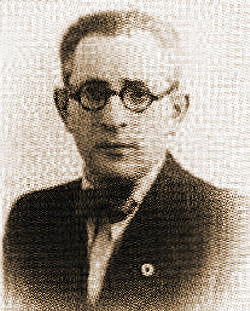
‘Rudy Paweł’ found shelter in Bund member Dawid ‘Klein’ Klin’s flat at Chłodna 17 street. There he met ‘Antek’ Cukierman, who described him as ‘gingerhead who spoke good German’. ‘Rudy Paweł’ later moved to Powiśle, took part in the 1944 Warsaw Uprising and was killed in action.
JMU leader Paweł Frenkel was killed at Grzybowska 11/13 along with his small squad. Someone informed the Germans about the group and German soldiers arrived there on 19th June 1943. After a few hours’ shootout, the Jews committed suicide, blowing up the bunker. Both Wdowiński and Halperin confirm this version of events. Halperin wrote: ‘all of the fighters died, including Paweł Frenkel and members of the command’.
Ideological division and the death of JMU’s leaders led to their role in the uprising being marginalized, omitted or distorted. This happened both in Polish and Jewish historiography, resulting in the appearance of fictitious persons such as Dawid Apfelbaum or circulation of unproved rumors about the JMU’s cooperation with Polish underground Military Organization (since 1944 named Security Corps). Israeli Zionist Revisionist party Herut strongly promoted Etzel (Irgun, or The National Military Organization in the Land of Israel) which fought the British and the Arabs in the Palestine, but ignored the Revionists fighters among the European Jews. Nonetheless, the role of the Jewish Military Organization in the Warsaw Ghetto Uprising still remains largely obscure. Due to a lack of documents and detailed accounts, it is impossible to verify the facts.
Sources:
Archiwum Ringelbluma. Konspiracyjne Archiwum Getta Warszawy. Tom 29a. Pisma Emanuela Ringelbluma z bunkra, ed. Eleonora Bergman, Tadeusz Epsztein, Magdalena Siek, Warszawa 2018
Archiwum Ringelbluma. Konspiracyjne Archiwum Getta Warszawy. Tom 34. Getto warszawskie, cz. II, red. Tadeusz Epsztein, Warszawa 2016
Anna Bikont, Niespotykany wysyp kombatantów [an interview with Monika Polit, https://www.holocaustresearch.pl/index.php?mod=news&show=225&template=print, access: 1.04.2020]
Mosze Arens, Flagi nad gettem: rzecz o powstaniu w getcie warszawskim, Kraków 2011
Barbara Engelking, Jacek Leociak, Getto warszawskie – przewodnik po nieistniającym mieście, Warszawa 2001
Dariusz Libionka, Laurence Weinbaum, Bohaterowie, hochsztaplerzy, opisywacze: wokół Żydowskiego Związku Wojskowego, Warszawa 2011
69 lat manipulacji historią Żydowskiego Związku Wojskowego [https://dzieje.pl/aktualnosci/libionka-69-lat-manipulacji-historia-zydowskiego-zwiazku-wojskowego; access: 1.04.2020]
Justyna Majewska, Powstanie w getcie warszawskim [https://www.jhi.pl/blog/2019–04–19-powstanie-w-getcie-warszawskim; access: 1.04.2020]
Emanuel Ringelblum, Stosunki polsko-żydowskie w czasie drugiej wojny światowej: uwagi i spostrzeżenia, Warszawa 1988
Ruta Sakowska, Ludzie z dzielnicy zamkniętej. Żydzi w Warszawie w okresie hitlerowskiej okupacji: październik 1939-marzec 1943, Warszawa 1975
Jürgen Stroop, Żydowska dzielnica mieszkaniowa w Warszawie już nie istnieje!, ed. Andrzej Żbikowski, Warszawa 2009
Paweł Szapiro, Powstanie w getcie warszawskim [in:] Polski słownik judaistyczny. Dzieje, kultura, religia, ludzie. Tom 2, ed. Zofia Borzymińska, Rafał Żebrowski, Warszawa 2003
Footnote:
[1] The Coordination Committee’s goal was to facilitate contact between the JCO and Bund despite political differences; during the Uprising, Bund actually became part of the JCO, as their 4 fighting squads became subject to common leadership.